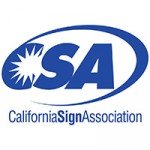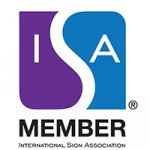Building Signs
Building signs, as they are typically referred to, are signs that are mounted to the face of the building and used to identify a place of business. They are typically placed over the entrance to the building or higher to provide better visibility. Additional signs are often placed in multiple locations on the building to enhance visibility from adjacent streets or parking areas. There are many types of building signs, but the majority fall into two categories: cabinet signs and individual letters. The most common signs are referred to as cabinet signs. These signs are generally rectangular or square in shape, and have a flat or formed plastic face. Commonly faces are decorated with translucent paint or vinyl but another option is to make the face from routed aluminum with “push thru” acrylic letters or symbols. Illumination is typically achieved with florescent bulbs for ease of maintenance, but neon and LED are used as additional lighting options. Non-illuminated signs can be constructed from any number of materials, including metal, plastic, wood, or high density foam, and are often illuminated with external flood lights.
Neon Signs
Neon signs are available in a wide variety of colors that can be bent and formed into almost any shape. These shapes range from plain block letters to whimsical logos and designs. A licensed electrician is required to perform service to the sign, due to the higher voltages used. If properly installed and maintained, neon lighting is unrivalled in longevity and brilliance.
Flat Cut-out Letters
Non-illuminated individual letters can be made from a metal, plastic, wood, foam, or a variety of other materials. They are typically machine routed or water-jet cut and either flush-mounted or pin-mounted to a wall.
Channel Letters
Channel letters are individually fabricated letters and logos mounted to a building or structure. They are very popular because they have a clean modern appearance and are often specifically required by landlords or cities. There are a number of different types of channel letters, which are used for different applications or effects.
Standard Face-Lit Channel Letters are the most common type of illuminated letters. These consist of an aluminum cabinet in the shape of the letter, with either neon or LED internal illumination and a plastic face. These letters are well suited to applications that require maximum visibility.
Halo (or Reverse) channel letters, while similar to standard channel letters, have an opaque face and clear back to reflect light on to the wall creating an outline, or halo effect. This creates a much more subtle lighting effect than a standard channel letter and is well suited for professional and interior applications, where the brightness of a standard letter is not needed or desired.
Face and Halo lit channel letters combines the characteristics of a standard channel letter with halo illumination. Both the face and back of the letter illuminate, creating an interesting effect suitable for a variety of applications, including entertainment and retail.
Additional on Chain Letters
Channel letters can be mounted in a variety of ways. The standard method is to directly mount the letters flush to a wall or building, but they may also be mounted to stand off the wall in order to allow drainage behind the letter. In addition to mounting letters directly to the wall, another common application is to mount the letters to a raceway, which is then mounted to the wall. The raceway is typically painted to match the wall so as to be less noticeable. This method has a number of advantages, including reduced installation time in the field and fewer wall penetrations and therefore fewer holes to patch if the sign is removed in the future.
Free Standing Signs
Freestanding signs are any signs that are not attached to a building or other structure. Broadly they can be divided into pole signs and lower-profile monument signs. These signs are generally used to provide the primary identification for a business or shopping center. They are almost always oriented perpendicular to the roadway in order to provide the best visibility to motorists from a distance.
Monument Signs
Monument signs are positioned at ground level and designed to identify a place of business to motorists or pedestrians passing by. These signs are shorter than pole signs, anywhere from 3 to 15 feet in height, and are characterized by having a base or pedestal that covers the support structure. Businesses will use monument signs in areas where traffic is moving slower and there are not as many obstructions. Monument signs are often required by landlords or city codes in order to reduce the clutter of pole signs, and provide a consistency in design to an area or shopping center. As a result, monument signs are very often designed to complement the building or shopping center. In some cases this works very well, but occasionally it can result in a business not receiving the proper identification needed to succeed.
Monument signs, like pole signs, can be used to identify one business or several businesses. If used for several businesses, it is considered a multi-tenant monument (or pole) sign, with each tenant receiving a separate panel on the sign. Primary or anchor tenants in a shopping center will often have the larger panels at the top of the sign, with the smaller tenants having smaller, usually equal-sized panels.
Pole Signs
Pole signs, also know as pylon signs, are characterized by a support structure consisting of poles or columns, and a sign cabinet located at the top of the sign. These signs can be constructed from a simple pole and cabinet design, or an elaborate structure with architectural elements such as tile, stucco, and cornices to match the building appearance.
The largest pole signs (with the exception of the Las Vegas style spectaculars) are usually freeway oriented signs; which must be taller and larger to attract customers from great distances or traveling at a high rate of speed. These signs can be 100 feet, or higher, if the local codes allow and the conditions warrant. Often the terrain and freeway orientation are major factors when determining height and size of the structure. These signs are especially important to gas stations, restaurants, and hotels that depend on freeway traffic for the majority of their business.
Street oriented pole signs are usually smaller, in the 20 to 50 foot height range, and are designed to be visible to motorists traveling along surface streets at a lower rate of speed and within a block or two of the business itself. The signs are tall enough to be seen above cars, landscaping and other roadside obstacles, but not so tall as to be out of the range of vision for motorists. Often these smaller pole signs will be used in conjunction with freeway signs to create a comprehensive wayfinding sign plan.
At CNP we offer customized programs for our clients that inspect the integrity and safety of their free-standing signs. Inspecting the footings, pipe and welds of pole signs can help stop corrosion of the steel and reduce liabilities through weld failures. Click here to learn more about our Service and Maintenance programs.


